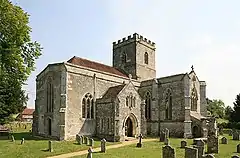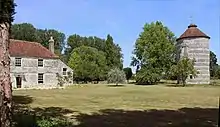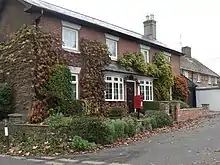Bishopstone, Salisbury
Bishopstone is a village and civil parish in Wiltshire, in the Ebble valley, about 5.5 miles (9 km) south-west of Salisbury. The parish includes the small village of Croucheston south of the river and the hamlet of The Pitts (now Pitts Road).
| Bishopstone | |
|---|---|
 Church of St John the Baptist, Bishopstone | |
 Bishopstone Location within Wiltshire | |
| Population | 684 (in 2011)[1] |
| OS grid reference | SU069257 |
| Civil parish |
|
| Unitary authority | |
| Ceremonial county | |
| Region | |
| Country | England |
| Sovereign state | United Kingdom |
| Post town | Salisbury |
| Postcode district | SP5 |
| Dialling code | 01722 |
| Police | Wiltshire |
| Fire | Dorset and Wiltshire |
| Ambulance | South Western |
| UK Parliament | |
| Website | Village |
History
The area was settled in prehistoric times. There was a bowl barrow near Croucheston Down Farm [2] and Grim's Ditch, a prehistoric earthwork, forms the southern boundary of the parish.[3]
The Roman road from Old Sarum to Dorchester crosses the parish.[4]
The village may have been known as Eblesborne because the land was owned by a man called Ebbel near the burna (river) .[5]
The village of Eblesborne is mentioned by historian Michael Wood in his book Domesday, a Search for the Roots of England because in 902 the Bishop of Winchester leased an estate in 'Ebbesbourne' to Beornwulf at a rent of 45/- a year.[5] In the book Ebbesbourne Wake through the Ages Peter Meers mentions Bishopstone.[5]
By 1166 the village had been acquired by the See of Winchester and the name changed to Bissopeston because of its ownership by the Bishopric.
Domesday Book The Domesday Book in 1086 divided the Chalke Valley into eight manors, Chelke (Chalke - Broad Chalke and Bowerchalke), Eblesborne (Ebbesbourne Wake), Fifehide (Fifield Bavant), Cumbe (Coombe Bissett), Humitone (Homington), Odestoche (Odstock), Stradford (Stratford Tony and Bishopstone) and Trow (circa Alvediston and Tollard Royal).[5]


The Parish Today
The parish contains six ancient villages, possibly since Saxon times. To the north of the river these were Bishopstone, Netton and Flamston; to the south, Throope, Faulston and Croucheston. Names of former settlements survive in Netton Farmhouse (1637),[6] Throope Manor (18th century),[7] and Faulston House (17th century).
[8] The roadside settlement known as The Pitts developed in the 19th century.
Religious sites
The parish church of St John the Baptist is Grade I listed.[9] Evidence survives of a 12th-century building, which was rebuilt as a cruciform church in the 13th century. The tower and two-storey porch were added in the 15th century and restoration was carried out in the 19th.[10][11] There are several monuments outside. By the south transept, a small stone cloister of two vaulted bays shelters a decorated tomb chest, perhaps that of the founder of the church. In the north transept is another richly decorated tomb recess, with stone coffin-lids, and in the south transept a mid-19th-century Gothic monument to a former rector by A. W. Pugin. At one time, above this was a window designed by Pugin and executed by William Wailes; this has since been replaced by clear glass.
A Primitive Methodist chapel was opened in 1833 at Croucheston and continued in use until 1978.[12]
Amenities
A school was built in Pitts road in 1843 and educated children of all ages until 1932 when it became a junior school, closing in 1977 due to falling pupil numbers.[10][13]
Bishopstone has a village hall[14]
It also has a pub, the White Hart. It had another, the Three Horseshoes in an 18th-century building,[15] but this closed in 2002.[16]
References
- "Bishopstone - 2011 Census". Neighbourhood Statistics. Office for National Statistics. Retrieved 20 October 2015.
- Historic England. "Croucheston Down Barn round barrow (1004772)". National Heritage List for England. Retrieved 22 October 2015.
- Historic England. "Grim's Ditch: Old Lodge Copse to Toyd Clump (1003457)". National Heritage List for England. Retrieved 22 October 2015.
- Historic England. "Knighton Roman road (1003728)". National Heritage List for England. Retrieved 22 October 2015.
- Ebbesbourne Wake through the Ages by Peter Meers
- Historic England. "Netton Old Farmhouse, Bishopstone (1318743)". National Heritage List for England. Retrieved 22 October 2015.
- Historic England. "Throope Manor, Bishopstone (1183069)". National Heritage List for England. Retrieved 22 October 2015.
- Historic England. "Faulston House, Bishopstone (1318741)". National Heritage List for England. Retrieved 22 October 2015.
- Historic England. "Church of St John the Baptist, Bishopstone (1146195)". National Heritage List for England. Retrieved 25 August 2015.
- "Victoria County History - Wiltshire - Vol 11 pp3-19 - Parishes: Bishopstone". British History Online. University of London. Retrieved 21 October 2015.
- "Church of St. John the Baptist, Bishopstone". Wiltshire Community History. Wiltshire Council. Archived from the original on 23 October 2015. Retrieved 21 October 2015.
- "Primitive Methodist Chapel, Bishopstone". Wiltshire Community History. Wiltshire Council. Archived from the original on 22 October 2015. Retrieved 21 October 2015.
- "Church of England School, Bishopstone". Wiltshire Community History. Wiltshire Council. Archived from the original on 23 October 2015. Retrieved 21 October 2015.
- "Community First - Bishopstone Village Hall, Salisbury". www.communityfirst.org.uk. Archived from the original on 4 March 2016. Retrieved 21 October 2015.
- Historic England. "The Three Horseshoes (1318740)". National Heritage List for England. Retrieved 22 October 2015.
- "Bishopstone". Wiltshire Community History. Wiltshire Council. Archived from the original on 23 October 2015. Retrieved 22 October 2015.
- The geographic coordinates are from the Ordnance Survey.
External links
![]() Media related to Bishopstone (near Salisbury) at Wikimedia Commons
Media related to Bishopstone (near Salisbury) at Wikimedia Commons